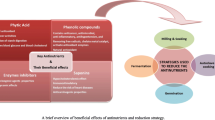Abstract
The objective of this study was to determine the contents of heavy metals in some common spices commercially available in the North Shewa Zone, Oromia region, Ethiopia. Korarima seed (Aframomum corrorima), ginger rhizome (Zingiber officinale), red pepper fruit (Capsicum annum), and turmeric rhizome (Curcuma longa) samples were randomly collected from the Fiche open market. These spice samples were digested using a mixture of 3 mL of HNO3 (69–72%) and 1 mL of HClO4 (70%), where organic components are assumed to decompose into gaseous forms while other heavy metal elements are left in the solution. The contents of heavy metals (Fe, Zn, Cu, Cr, Mn, Ni, Cd, and Pb) in the spices were determined by inductively coupled plasma‒optical emission spectrometry (ICP‒OES). The results obtained showed that the concentrations of heavy metal in the korarima, red pepper, ginger, and turmeric samples in milligrammes per kilogramme of dry weight were in the range of Fe (38.7–98.9), Mn (10.5–257), Zn (7.30–29.2), Cu (1.70–6.50), Cr (5.40–9.70), Cd (1.50–2.90), Pb (14.5–28.4), and Ni (3.90–6.70). The heavy metal contents in korarima, red pepper, ginger, and turmeric samples were compared with the maximum values given by the World Health Organization (WHO). Accordingly, the Fe, Zn, Cu, Cr, Mn, and Ni values in the spice samples were found to be lower than the maximum limit of the WHO, while the levels of Pb and Cd in four spice samples and Mn (only in ginger) were higher than the WHO permissible limit. This study shows that the consumption of korarima, red pepper, ginger, and turmeric may pose a serious health threat to consumers due to the high content of lead, cadmium, and manganese (only in ginger) in spices. Therefore, it is suggested that further study be conducted on spice samples based on the origin of cultivation to determine which hotspot is responsible for high levels of contamination of lead, cadmium, and manganese to protect consumers.


Similar content being viewed by others
Data Availability
Data are available in supplementary materials.
References
Mollah MA, Rabbany G, Nurunnabi M, Shahriar SS, Salam SMA (2022) Health risk assessment of heavy metals through six common spices of Mohanpur Upazila of Rajshahi. Glob J Nutr Food Sci 3(5):1–8
Islam MZ, Rahman SS, Das AK, Kamruzzaman M, Rahman MH (2022) Nutritional analysis and determination of heavy metal content of some spices from the the Northern Region. Bangladesh Food Nutr Sci 13:558–567
Mekassa B, Chandravanshi BS (2015) Levels of selected essential and nonessential metals in seeds of korarima (Aframomum corrorima) cultivated in Ethiopia. Braz J Food Technol 18(2):102–111
Savić S, Petrović S, Petronijević M, Cvetanović A, Petronijević Ž (2019) Determination of the mineral content of spices by ICP-OES. Adv Technol 8(1):27–32
Bamigboye AY, Adepoju OT, Oladipo O (2020) Evaluation of physicochemical properties and mineral content of some indigenous spices retailed in Ibadan. Nigeria Int J Nutr 6(1):20–34
Tesfa T, Bayu W, Gashaw A, Beshir H, Box PO (2017) Spice production, marketing, and utilization in South Wollo, Ethiopia. East African J Sci 11(1):27–36
Shimelis T (2021) Spices production and marketing in Ethiopia : a review Spices production and marketing in Ethiopia. A Cogent Food Agric 7(1):1915558
Gottardi D, Bukvicki D, Prasad S, Tyagi AK, Gänzle M, Torres CF (2016) Beneficial effects of spices in food preservation and safety. Front Microbiol 7:1–20
Reinholds I, Pugajeva I, Bavrins K, Kuckovska G (2017) Mycotoxins, pesticides, and toxic metals in commercial spices and herbs. Food Addit Contam Part B 10(1):5–14
Nkansah MA, Amoako CO (2010) Heavy metal content of some common spices available in markets in the Kumasi metropolis of Ghana. Am J Sci Ind Res 1(2):158–163
Soliman NFE (2015) Metals contents in spices and herbs available on the Egyptian market : assessment of potential human health risk. Open Conf Proc J 6:24–29
Kowalska G (2021) The safety assessment of toxic metals in commonly used herbs, spices, tea, and coffee in Poland. Int J Environ Res Public Health 18:5779
Tefera M, Chandravanshi BS (2018) Assessment of metal contents in commercially available Ethiopian red pepper. Int Food Res J 25(3):989–1000
Tegegne WA, Mengiste AA (2016) Determination of essential and non-essential metals concentration in garlic (Allium sativum L.) bulb and leaf cultivated in Ambo Woreda, Ethiopia. Sci J Anal Chem 4(6):84–94
Jomova K, Makova M, Alomar SY, Alwasel SH, Nepovimova E, Kuca K, Rhodes CJ, Valko M (2022) Essential metals in health and disease. Chem Biol Interact 367:110173
Seddigi ZS, Kandhro GA, Shah F, Danish E, Soylak M (2016) Assessment of metal contents in spices and herbs from Saudi Arabia. Toxicol Ind Health 32(2):260–269
Tefera M, Teklewold A (2021) Health risk assessment of heavy metals in selected Ethiopian spices. Heliyon 7:e07048
Manousi N, Isaakidou E, Zachariadis GA (2022) An inductively coupled plasma optical emission spectrometric method for the determination of toxic and nutrient metals in spices after pressure-assisted digestion. Appl Sci 12:534
Umar MA, Salihu ZO (2014) Heavy metals content of some spices available within FCT-Abuja, Nigeria. Int J Res Agric Food Sci 4(1):66–74
Aberie ZZ, Sallilh FZ, Medfu Tarekegn M (2021) Investigation of heavy metals in selected local spices consumed in Ethiopia. Cogent Food Agric 7(1):1917091
Wagesho Y, Chandravanshi BS (2015) Levels of essential and non-essential metals in ginger (Zingiber officinale) cultivated in Ethiopia. Springerplus 4:107
Kaba FT, Doda MB, Kanido CK (2020) Levels of selected essential and non-essential metals in the soil and ginger (Zingiber officinale) cultivated in Wolaita Zone. J Agric Chem Environ 9:276–298
Goroya KG, Mitiku Z, Asresahegn YA (2019) Determination of concentration of heavy metals in ginger using flame atomic absorption spectroscopy. African J Plant Sci 13(6):163–167
Getaneh A, Guadie A, Tefera M (2021) Levels of heavy metals in ginger (Zingiber officinale Roscoe) from selected districts of Central Gondar Zone, Ethiopia, and associated health risk. Heliyon 7(4):e06924
Admasu S, Chandravanshi BS, Yohannes W (2018) Levels of selected metals in the leaves of Ruta chalepensis L. (Rue) collected from four different areas of Ethiopia. Bull Chem Soc Ethiop 32:185–197
Miller JM, Miller JC (2010) Statistics and chemometrics for analytical chemistry, 6th edn. Pearson Practice Hall, England
Chauhan A, Mittu B, Chauhan P (2015) Analytical method development and validation : a concise review. J Anal Bioanal Tech 6(1):1–5
Desimoni E, Brunetti B (2015) About estimating the limit of detection by the signal to noise approach. Pharm Anal Acta 6(3):355
Potortì AG, Lo Turco V, Di Bella G (2020) Chemometric analysis of elements content in Algerian spices and aromatic herbs. LWT - Food Sci Technol 138(110643):30
Lopez AM, Nicolini CM, Aeppli M, Luby SP, Fendorf S, Forsyth JE (2022) Assessing analytical methods for the rapid detection of lead adulteration in the global spice market. Environ Sci Technol 56(23):16996–17006
Russom E, Kfle G, Asgedom G, Goje T (2019) Heavy metals content of spices available on the market of Asmara. Eritrea Eur J Nutr Food Saf 11(3):156–163
Withanage N, Wickramasinghe I, Rajanayake RMGB, Bamunuarachchi A (2015) Analysis of metal content in turmeric powder available in the Sri Lankan market. Int J Eng Sci Res Technol
Kiliçel F, Karapinar HS (2018) Determination of trace element contents of some spice samples by using FAAS. Asian J Chem 30(7):1551–1558
Krejpcio Z, Król E, Sionkowski S (2007) Evaluation of heavy metals contents in spices and herbs available on the Polish market. Polish J Environ Stud 16(1):97–100
Bazargani-gilani B, Pajohi-alamoti M (2017) Evaluating of heavy metal contaminations in the most applicable food spices and flavours in Hamedan. Iran Arch Hyg Sci 6(3):268–275
Gaya UI, Ikechukwu S (2016) Heavy metal contamination of selected spices obtained from Nigeria. J Appl Sci Environ Manag 20(3):681–688
Soylak M, Tuzen M, Narin I, Sari H (2004) Comparison of microwave, dry, and wet digestion procedures for the determination of trace metal contents in spice samples produced in Turkey. J Food Drug Anal 12(3):254–258
Getaneh A, Guadie A, Tefera M (2021) Levels of heavy metals in ginger (Zingiber of fi cinale Roscoe) from selected districts of Central Gondar Zone, Ethiopia and associated health risk. Heliyon 7:e06924
Ibrahim GI, Hassan LM, Baban SO (2012) Effect of heavy metal content of some common spices available in local markets in Erbil City on human consumption. Raf J Sci 23(3):106–114
Sangeetha VJ, Dutta S, Moses JA, Anandharamakrishnan C (2022) Zinc nutrition and human health: overview and implications. eFood 3(5):e17
Paun S, Tudosie M, Petris R, Macovei R (2012) The effects of zinc on the human body, including on renal failure and renal transplantation. J Med Life 5(5):137–140
Waziri M, Adamu IA (2014) Comparative study of heavy metal concentration in Capsicum annum (pepper) cultivated in North Eastern Nigeria. Int J Sci Res 3(10):2012–2015
Grace FA, Adewale OO, Olawale AI (2020) Assessment of heavy metals in peppers sold in major markets in Osogbo, Osun State, Southwest, Nigeria. Int J Adv Res Chem Sci 7(9):1–8
Islam S, Chowdhury AI, Shill LC, Reza S. (2023) Heavy metals induced health risk assessment through consumption of selected commercially available spices in Noakhali District of Bangladesh. https://doi.org/10.1101/2023.02.06.23285555
Rahman A, Akter T, Akter R, Sarkar BK (2020) Analysis of heavy metal contents in some commercial turmeric samples available at Dhaka, Bangladesh. Jahangirnagar Univ J Biol Sci 9(1&2):13–20
Muhib MI, Chowdhury MAZ, Easha NJ, Rahman MM, Shammi M, Fardous Z et al (2016) Investigation of heavy metal contents in cow milk samples from the area of Dhaka, Bangladesh. Int J Food Contam 3(1):1–10
Mohammed MJ (2022) Assessment of heavy metal contents in some common spices available in the local markets of Tikrit. Poll Res 40(4):1440–6
Abbaspour N, Hurrell R, Kelishadi R (2014) Review on iron and its importance for human health. J Res Med Sci 19:164–174
Al DAS, Alkhatib DH, Jaleel A, Naveed M, Tariq M, Feehan J et al (2023) Proximate composition and mineral content of spices increasingly employed in the Mediterranean diet. J Nutr Sci 212(2):1–7
Muhammed S, Birhanu T (2020) Major bovine parasitic zoonosis at selected municipal abattoirs, North Shewa Zone. Int J Vet Sci Res 6:148–153
Acknowledgements
The authors would like to thank the Department of Chemistry, Salale University, for financial support for this research. Additionally, we would like to express our thanks to Horticoop Ethiopia (Horticulture) PLC, Bushoftu, for providing laboratory facilities during the study period.
Author information
Authors and Affiliations
Contributions
This research was conducted by T. A. G. S. wrote the manuscript and prepared the figures, while Girma Regassa contributed to further elaborating and discussing this article. All the authors have read and agreed to the published version of the manuscript.
Corresponding author
Ethics declarations
Competing Interests
The authors declare no competing interests.
Additional information
Publisher's Note
Springer Nature remains neutral with regard to jurisdictional claims in published maps and institutional affiliations.
Supplementary Information
Below is the link to the electronic supplementary material.
Rights and permissions
Springer Nature or its licensor (e.g. a society or other partner) holds exclusive rights to this article under a publishing agreement with the author(s) or other rightsholder(s); author self-archiving of the accepted manuscript version of this article is solely governed by the terms of such publishing agreement and applicable law.
About this article
Cite this article
Adugna, T., Selale, G. & Regassa, G. Assessment of Heavy Metal Contents in Some Common Spices Available in the Local Market of North Shewa Zone, Oromia Regional State, Ethiopia. Biol Trace Elem Res (2023). https://doi.org/10.1007/s12011-023-03921-8
Received:
Accepted:
Published:
DOI: https://doi.org/10.1007/s12011-023-03921-8




